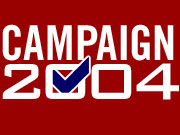|
Audio
Photos
More from MPR
Resources
Respond to this story
|
Voting made easy by following rules, asking questions
November 1, 2004
 |
| Minnesota Secretary of State Mary Kiffmeyer says voters can register at the polls if they bring proper identification. (MPR Photo/Tim Pugmire) |
St. Paul, Minn. — Experts often describe voting in Minnesota as an easy process. The requirements are simple. You must be at least 18 years old, a U.S. citizen and a resident of the state for at least 20 days.
Minnesota Secretary of State Mary Kiffmeyer says people who meet those basic standards are then allowed to register. In Minnesota, voters who haven't registered in advance can do so at the polls. But Kiffmeyer says they must bring proper identification.
"The most common tool that is used to verify who you are and where you live is a Minnesota drivers license with your current address on it," Kiffmeyer said. "If you don't drive, a Minnesota identification card will work just as well -- it uses the same process."
Many eligible voters have moved recently, and their license doesn't show a current address. Kiffmeyer says those voters must provide additional information.
"They can use the last four digits of their Social Security number, in combination with a utility bill that is a current one with their name and address on it," Kiffmeyer said. "Sometimes a passport, military photo I.D. card, student photo I.D. -- these are tools that you can use in addition."
College students always make up a big share of first-time voters. And they often have a driver's license that doesn't reflect their current college address. Joe Mansky, elections manager for Ramsey County, says he gets enrollment lists from local colleges that help students register on Election Day. He says they only need to show a valid student I.D. Mansky says students from out of state have another decision to make.
|
Many students consider themselves to be Minnesota residents while they're going to school here, and they then have the right to register and vote in our elections.
- Joe Mansky, Ramsey County elections manager |
"If they consider themselves still residing with their parents in Wisconsin or Iowa or somewhere else, then what they should be doing is getting an absentee ballot from their home state," Mansky said. "However, many students consider themselves to be Minnesota residents while they're going to school here, and they then have the right to register and vote in our elections."
Mansky says another option for someone trying to register at the polls is to bring along a registered voter from the same precinct to vouch for their residency.
There are 3,800 polling places in Minnesota. People who've voted in the last four years and haven't changed addresses will find their names on the precinct roster when they sign in. Voters who are unsure of where to go can check with the Secretary of State's Web site or their county election office.
There are 30,000 election judges across the state ready to answer questions about the voting booth and the election ballot. Joe Mansky says there are 100 bilingual judges in the city of St. Paul.
"About half that number speak both Hmong and English," Mansky said. "And we will have them stationed in the parts of St. Paul that tend to have the more sizable Hmong populations. We also have a fairly large number of judges who speak both Spanish and English, who'll be working on the west side and parts of the east side."
The list of election rules also spells out specific restrictions at polling places. Secretary of State Kiffmeyer says the political party representatives who are standing by to challenge voter eligibility must speak directly with election judges, not voters. She also warns voters not to show their candidate preferences when it's time to vote.
"If you've been out campaigning before you come to vote, be sure you put on a jacket and cover up your T-shirt, take off your button, stick then in your pocket or wear them later," Kiffmeyer said. "Within 100 feet of a polling place door there's no campaigning, signs -- don't park your car with bumper stickers -- things like that. It's a no-campaign zone."
High turnout might cause delays at many polling places. Kiffmeyer urges voters to come prepared with the required identification and have plenty of patience.
|
News Headlines
|
Related Subjects
|

